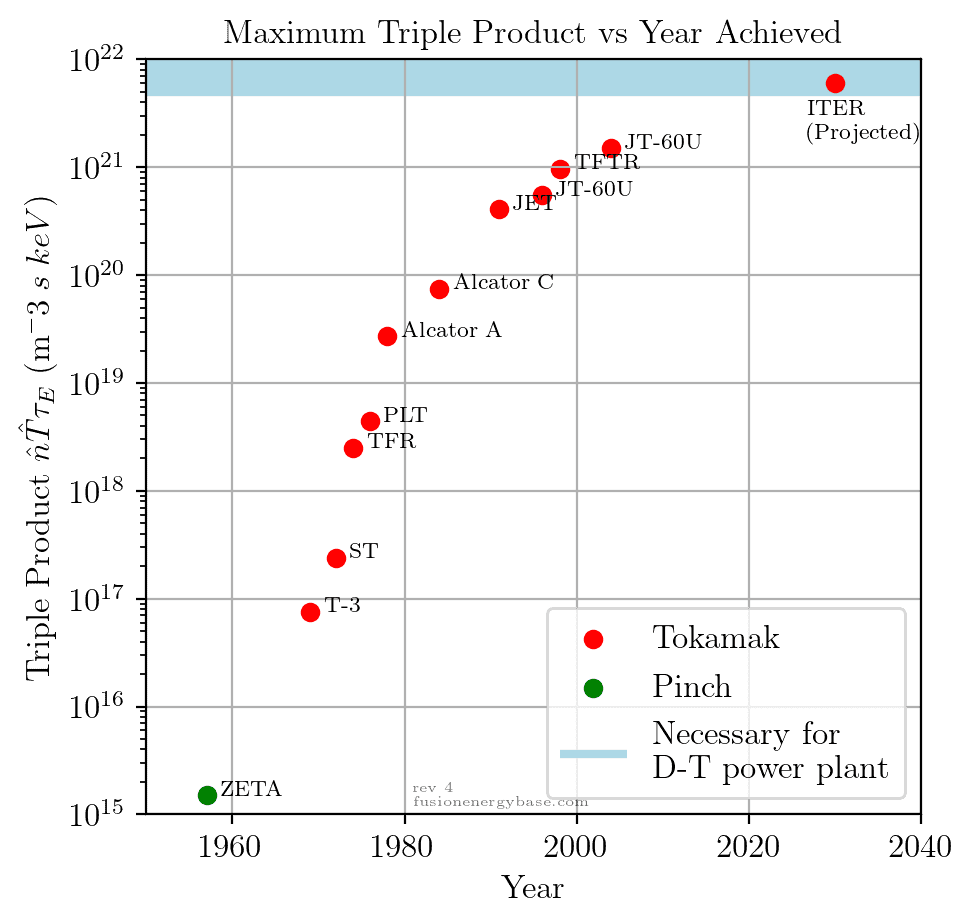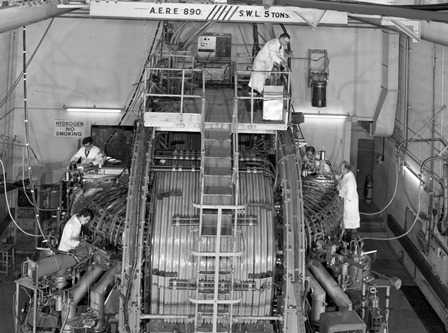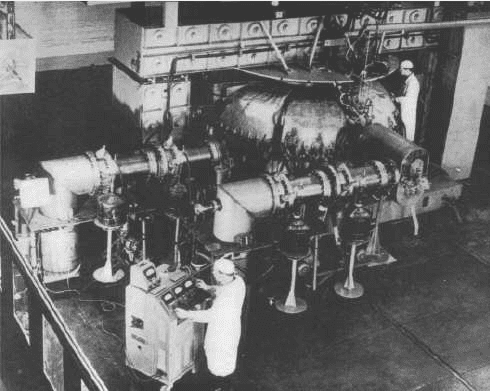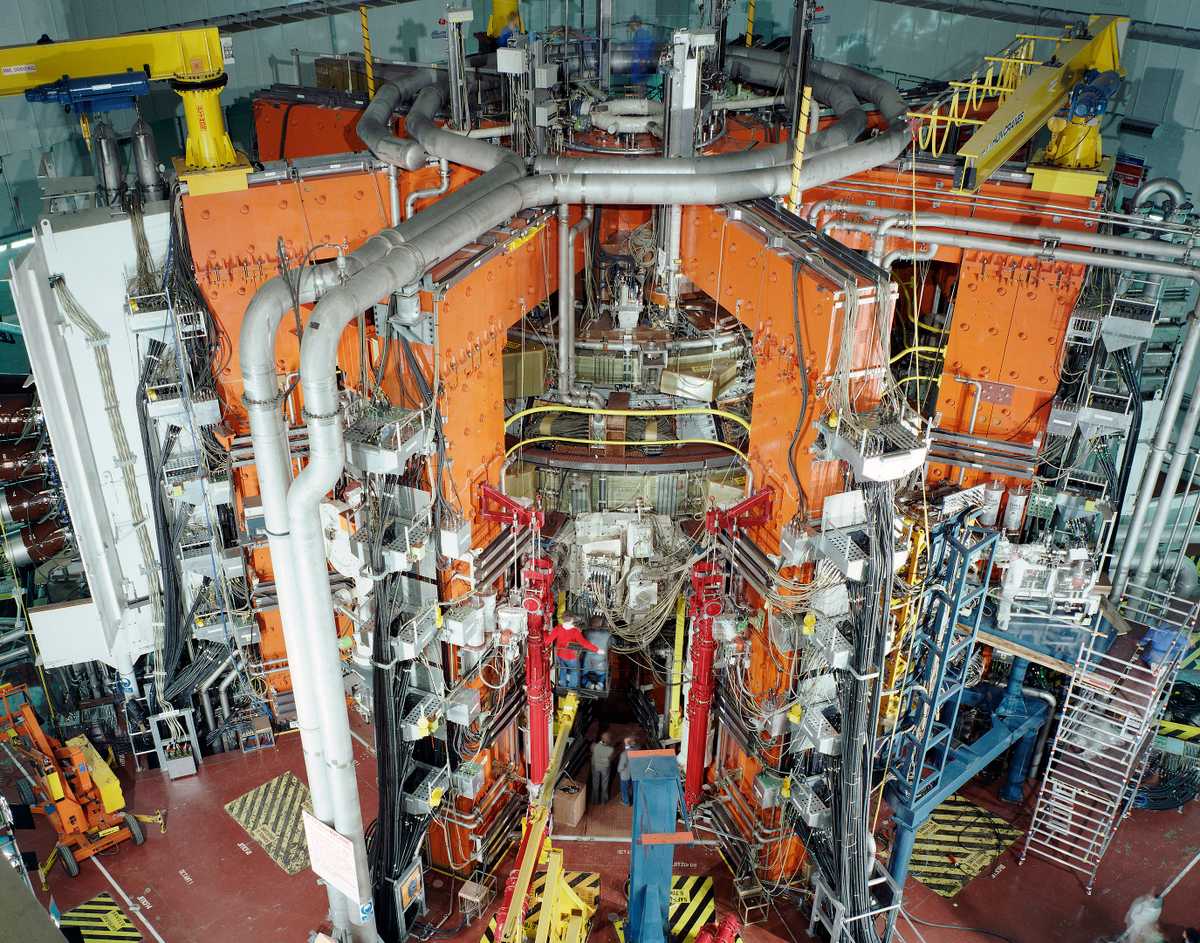Measuring Progress in Fusion Energy: The Triple Product
December 19, 2019 | Sam WurzelA major goal of fusion energy1 research is to heat and confine an ionized gas (a plasma) of light elements like hydrogen so they fuse into heavier elements, producing significantly more power from fusion reactions than power put into the plasma for heating. While the schemes for achieving this vary widely, a single value tells us how close a fusion experiment is to net power: the fusion triple product. As the name suggests, the triple product is the product of three attributes of a fusion plasma:
- n the density of ions in the plasma (ions/cubic meter)
- T the temperature of those ions (keV2)
- τE the energy confinement time (seconds)
The fusion reaction with the lowest (and therefore most achievable) triple product threshold is the fusion of deuterium and tritium (D-T), two isotopes of hydrogen. A fusion power plant running on D-T fuel will have a triple product of about 5×1021 m-3 keV s or greater3. There are of course many other requirements for a commercially viable power plant but the triple product encapsulates a lot of the plasma physics so it's a good place to start the discussion.
A nice property of the triple product is that it’s independent of the particular scheme used to create the fusion plasma so it can be used to compare performance across different kinds of approaches to fusion4. It’s a meaningful quantity in magnetic confinement schemes (tokamaks, stellarators), inertial confinement schemes (laser fusion), and magneto-inertial schemes (MagLIF, compression of FRCs).
Between the 1950s and the early 2000s, the maximum triple product achieved by fusion energy experiments grew dramatically. Then, from the early 2000s to the present there haven't been any new records5 as efforts in fusion concentrate on ITER (Figure 1). It's a remarkable story and it's best to start at the beginning.
Figure 1: Plot of the increasing maximum achieved triple product and the year achieved. Peak values of ion temperature and density are indicated. The names of each experiment are indicated next to their achieved results. Experimental data from Fusion Energy Base. Projected value of ITER from published models.
Early Fusion Energy History: 1950s
During their post WWII optimism of the 1950s, the United States, the Soviet Union, and the United Kingdom mounted well funded, classified efforts to design and build fusion energy systems. A few early experiments initially reported promising results of high temperature plasmas and fusion neutrons, signatures of the D-T fusion reaction. But it was soon realized that this was a misinterpretation of the data. The source of the fusion reactions were areas of instabilities in the plasma, not from a uniformly hot plasma. The actual achieved triple products were very low, far below that required for a power plant. By the end of the 1950s the research was declassified and the field entered into a brief period of pessimism.
Figure 2: Photograph of the ZETA pinch experiment in the UK from the mid 1950s. Initial optimistic results from ZETA were later walked back. via Swansea University credit NDA (Nuclear Decommissioning Authority)
The Tokamak: 1960s to Today
The outside world was therefore understandably skeptical in 1968 when the Soviet Union reported heating of a plasma to 1 keV (more than ten times hotter than previously achieved) in a toroidal machine dubbed the “tokamak”. In a remarkable example of collaboration during the Cold War, an invited team of British plasma physicists travelled to Russia that fall to measure the plasma temperature with a cutting edge laser system and returned with the news: the report of 1 keV temperatures was true.
Figure 3: Photograph of the T-3 tokamak in the Soviet Union from the late 1960s. via All-the-world's Tokamaks
A rush of tokamak construction followed, and the achieved triple products climbed rapidly throughout the rest of the 20th century. The ability to drive higher triple products in tokamaks was the result of many advancements in the understanding of plasma physics, improved technologies, and an increase in tokamak size. The increase in size is important: larger tokamaks hold on to heat for a longer time, increasing their energy confinement times and hence their triple products. It also drives up their cost.
Figure 4: Photograph of the JET tokamak in 1991. Note the person (lower center) in grey for scale. EFDA JET CC BY-SA 3.0
The Present: ITER, Alternate Concepts and Advanced Tokamaks
ITER, which will be the world’s largest tokamak when it’s completed, is currently under construction in France. It’s designed to generate ten times more fusion power than heating power injected into the plasma and will likely reach this goal between 2035 to 2040 at a cost of over $25B. ITER is a critically important scientific experiment to understand the physics of plasmas that generate significantly more fusion power than they consume, and to provide a platform for the development of key technologies needed to handle plasmas at those extremes.
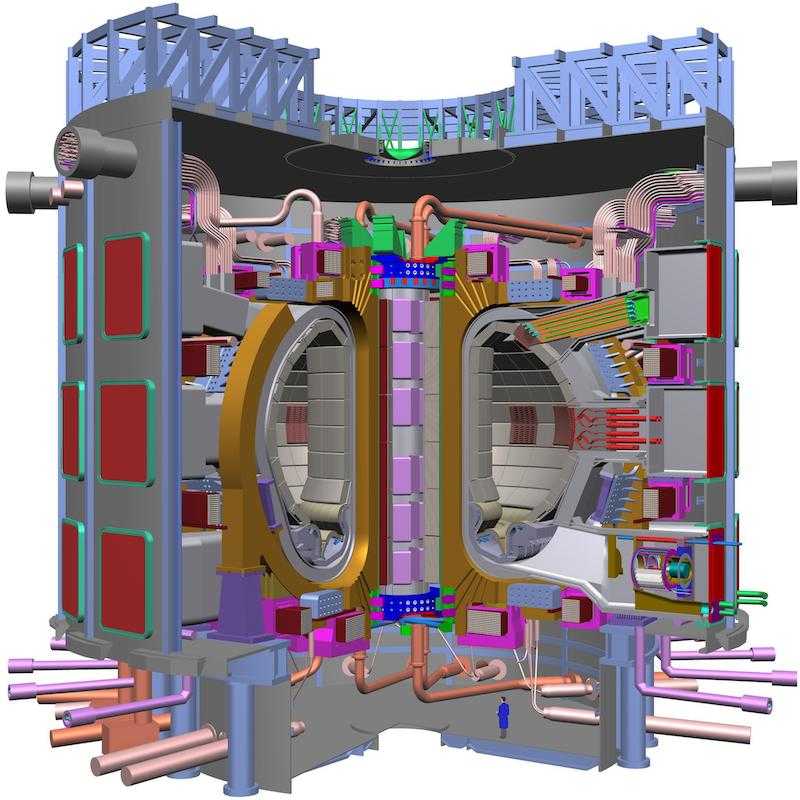
Figure 5: A cutaway illustration of the ITER tokamak. Note the person (lower right) in blue for scale. Credit ITER
But ITER is not the whole story of fusion development today. Work on non tokamak concepts (alternate concepts) and advanced tokamak designs focus on the goal of making fusion energy commercially viable. To understand these efforts we first need to dig deeper into the triple product and look at the plasma temperature which needs to exceed a certain threshold to reach power plant relevant conditions.
By graphing the triple product needed for a power plant as a function of plasma temperature6, Figure 6 shows that the lowest required triple product occurs for plasma temperatures between 10 and 20 keV. Anything less than 4 keV becomes extremely challenging.
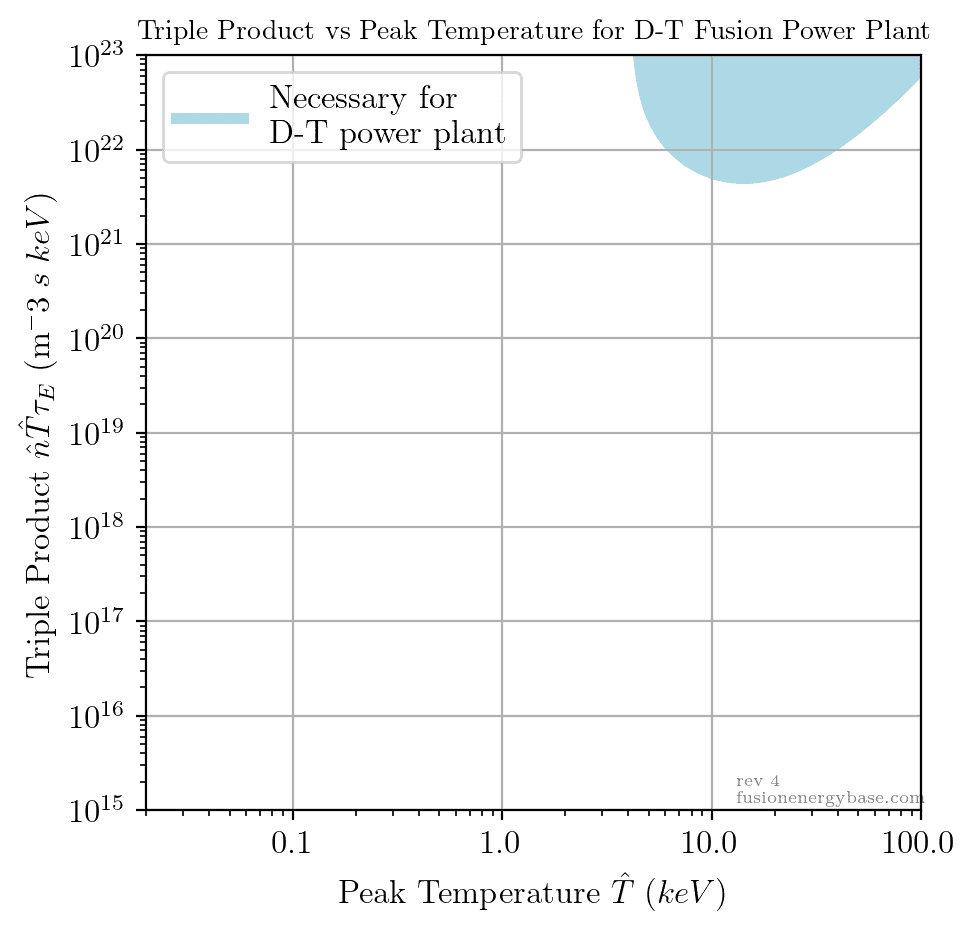
Figure 6: The approximate triple product range that is a necessary (but not sufficent) condition for a fusion power plant running on D-T fuel as a function of temperature.
Because of this temperature requirement, effective plasma heating is an important milestone for any fusion energy scheme and explains why the 1keV temperature7 result of the T-3 tokamak generated so much excitement in 1968: while 1keV is too low for a power plant, it’s within a factor of ten of what's required. Even now, combined with a reasonable scheme for plasma confinement, a temperature of 1keV is an exciting milestone8.
By plotting the achieved triple product vs achieved temperature we can get a sense of the progress of fusion experiments along both axes (Figure 4).
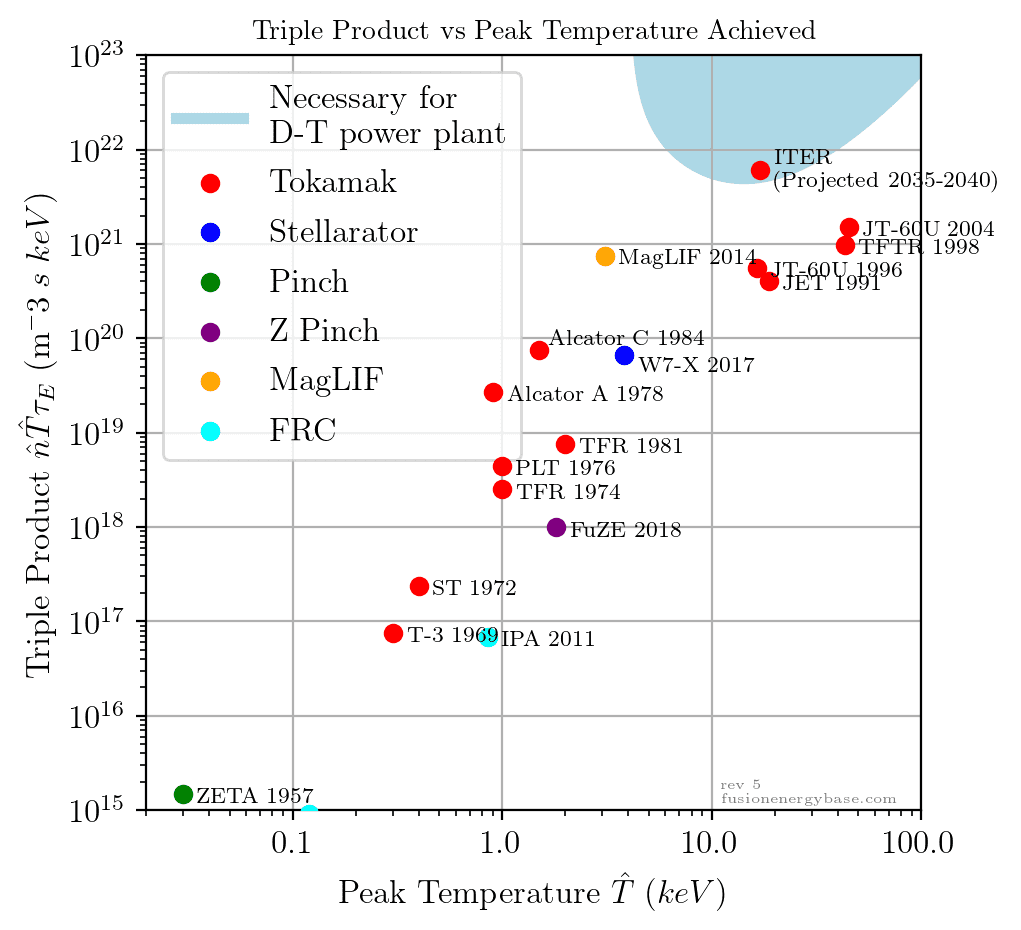
Figure 4: Achieved triple products and temperatures for selected experiments. Data from Fusion Energy Base. Additions, updates, and corrections are welcome.
This fuller picture shows:
- The original low temperature efforts of the 1950s which languished until the late 1960's achievement of 1keV temperatures in the Soviet T-3 tokamak
- The march of increasing triple product performance by tokamaks through the rest of the 20th century including the anticipated future result from ITER in the mid to late 2030s (the red dots)
- The recent results from alternate concepts demonstrating temperatures in the neighborhood of 1keV9
- The recent result from NIF which is close to the triple product conditions needed for a power plant but very far from the other efficiency and repetition rate conditions required by laser ICF schemes.
###The Future: Enabling Technologies, Fusion Energy Startups, and the Funding of Alternate Concepts and Advanced Tokamaks by the US and China The exciting recent results from alternate concepts are largely due to deep scientific understanding derived from 70 years of research in plasma physics and advances in computation and simulation. Additionally, advances in material science and manufacturing are enabling a new class of advanced tokamaks and stellarators, respectively.
These enabling technologies fall into three broad categories:
- Computation: Supercomputing for simulation and artificial intelligence for design, experimental optimization and active feedback
- Materials: High temperature superconductors, advanced semiconductor switches, advanced alloys and ceramics
- Manufacturing: Metal 3-D printing, computer aided design (CAD), and computer aided manufacturing (CAM)
Today, over 25 startup companies exist with the mission of generating economically viable power from fusion. All of them leverage the accrued scientific understanding of plasma physics and one or more of these enabling technologies. Most of them did not exist five years ago.
Governments and investors are taking note. In 2015 the US Department of Energy's ARPA-E ALPHA program funded nine groups over three years to work on new fusion approaches resulting in alternate concepts hitting 1 keV ion temperatures and neutrons from D-D fusion reactions at very modest levels of funding. And as of this writing, ARPA-E just announced a follow on program, BETHE which calls out specific triple product values as project milestones.
In 2016, the National Natural Science Foundation of China listed magneto-inertial fusion (a subset of alternate concepts) and advanced tokamaks as important national priorities in its strategic planning research report on China's 13th Five Year Plan. A number of alternate concept and advanced tokamak projects are rapidly being developed in China.
On the private investment side, venture capitalists, public companies, banks, and angel investors have injected over a billion dollars into fusion startups over the last decade. As more private money flows into this space, it behooves investors to inform themselves not just about power plant economics but also the basics of plasma physics, fusion technology and how each company plans to economically reach power plant relevant triple products. In this way investors can most effectively allocate capital to the development of a technology with the potential to shake up the economic sector with the largest total addressable market on earth: energy.
###Notes 1: For the purposes of this article we take fusion energy to mean controlled thermonuclear fusion, fusion due to the thermal motion of ions in a controlled way with the intention of using the net power to generate electricity or industrial heat. There are other ways of generating fusion reactions which cannot generate net power (e.g., simply accelerating a beam of ions at a target) but this discussion is limited to controlled thermonuclear fusion relevant to power plants.
- Temperatures in fusion research are typically written in units of keV (thousand electron volts) rather than degrees Celsius. 1keV is about 11,600,000°C.↩
- This triple product is roughly what's required for a tokamak where the temperature and densities are the peak values. For a uniform plasma the threshold is slightly lower. The exact threshold varies slightly between different concepts but the value quoted is a good approximation. A more detailed explanation merits a separate essay but a good place to start is the Lawson criterion.↩
- One caveat is that for the ion temperature (and therefore triple product) to be a meaningful quantity the ions must be “thermal”, meaning that their speeds have a bell shaped distribution. Examples of non thermal ions are beams of ions found in beam-target fusion schemes and ion populations in some electrostatic fusion schemes.↩
- Actually there was a triple product record set by a laser inertial confinement fusion (laser ICF) experiment at NIF (National Ignition Facility) in 2017. By blasting a sub-nanosecond pulse of 192 intense laser beams at a metal sleeve (hohlraum) containing a D-T target the size of a peppercorn, they briefly achieved a triple product of 1.6×1022 m-3 keV s. This result underscores the fact that a high triple product is necessary but not sufficient for a commercially viable power plant. Technically, more fusion energy was released than was absorbed by the fusion fuel which is consistent with the high triple product attained. However, the triple product doesn't say anything about the efficiency at which energy is delivered to fusion fuel or extracted to do useful work. Laser inertial fusion schemes have energy delivery efficiencies far below 1% (energy absorbed by the fusion fuel divided by the energy used to power the lasers) and therefore have major efficiency challenges to overcome. Aside from this issue, because the temperature achieved by NIF (about 5keV) is lower than the implied temperature of the blue line in Figure 1 (10keV to 20keV), it's omitted from the graph. That said, there is exciting laser ICF work underway to address these issues and a proper treatment deserves its own article.↩
- You may wonder why we are plotting the triple product as a function of temperature when the temperature itself is a factor in the triple product. In a nutshell, the condition necessary for a power plant can be expressed as an ion density times the energy confinement time which varies as a function of the temperature. Multiplying both sides of that equation gives the triple product as a function of temperature. The interrelationship of temperature, density, and energy confinement time is best understood through the derivation of the plasma ignition condition (see Footnote 3).↩
- While the T-3 tokamak achieved 1keV electron temperatures, the ions were somewhat cooler at 300eV.↩
- It's important to note that many important fusion experiments do not count high temperatures or high triple products as their goals. Instead, their goals are critical stepping stones to eventually reaching those levels, for example studying instabilities, developing novel confinement approaches, or exploring the limits of key technologies. But each of these goals can usually be connected to enabling high triple products down the line.↩
- Much like the British efforts to validate the claims of 1keV temperatures in the T-3 tokamak in 1968 using a laser system (Thomson scattering), similar efforts are planned to validate the reports of 1keV temperatures in contemporary alternate concepts to avoid a repeat of the ZETA situation.↩
